Oceanic whitetip shark
The oceanic whitetip shark (Carcharhinus longimanus), also known as shipwreck shark, Brown Milbert's sand bar shark, brown shark, lesser white shark, nigano shark, oceanic white-tipped whaler, and silvertip shark, is a large pelagic requiem shark inhabiting tropical and warm temperate seas. Its stocky body is most notable for its long, white-tipped, rounded fins.
| Oceanic whitetip shark | |
|---|---|
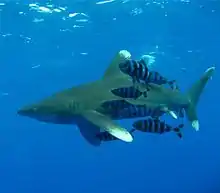 | |
| Female individual surrounded by Pilotfish in the Red Sea | |
| Scientific classification | |
| Kingdom: | Animalia |
| Phylum: | Chordata |
| Class: | Chondrichthyes |
| Superorder: | Selachimorpha |
| Order: | Carcharhiniformes |
| Family: | Carcharhinidae |
| Genus: | Carcharhinus |
| Species: | C. longimanus |
| Binomial name | |
| Carcharhinus longimanus (Poey, 1861) | |
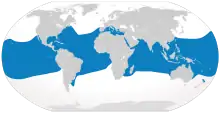 | |
| Range of the oceanic whitetip shark | |
| Synonyms[3] | |
| |
Though slow-moving, it is opportunistic and aggressive, and is reputed to be dangerous to shipwreck survivors.[4] Recent studies show steeply declining populations because its large fins are highly valued as the chief ingredient of shark fin soup, and as with other shark species, the whitetip faces mounting fishing pressure throughout its range.[5]
Taxonomy
The oceanic whitetip shark, or lesser white shark, was described in 1831 by naturalist René-Primevère Lesson, who named the shark Carcharhinus maou.[6] It was next described by Cuban Felipe Poey in 1861 as Squalus longimanus.[6] The name Pterolamiops longimanus has also been used. The species epithet longimanus refers to the size of its pectoral fins (longimanus translates from Latin as "long hands").[7] The oceanic whitetip shark has many common names in English: Brown Milbert's sand bar shark, brown shark, nigano shark, oceanic white-tipped whaler, and whitetip shark.[7]
The rules of the International Commission on Zoological Nomenclature are that in general the first-published description has priority; therefore, the valid scientific name for the oceanic whitetip shark should be Carcharhinus maou. However, Lesson's name remained forgotten for so long that Carcharhinus longimanus remains widely accepted.[8]
Distribution and habitat
The oceanic whitetip is found globally in deep, open oceans, with a temperature greater than 18 °C (64 °F),[3] although exceptionally it occurs in water as cold as 15 °C (59 °F).[1] It prefers waters between 20 and 28 °C (68–82 °F) and tends to withdraw from areas when temperatures fall outside of these limits.[1][8] It was once extremely common and widely distributed, and still inhabits a wide band around the globe; however, recent studies suggest that its numbers have drastically declined.[5] An analysis of the US pelagic longline logbook data between 1992 and 2000 (covering the Northwest and Western Central Atlantic) estimated a decline of 70% over that period.[1]
It is found worldwide between 45°N and 43°S latitude.[3] In September 2004, a 2.3 m (7.5 ft) vagrant oceanic whitetip shark was seen in the brackish waters of Gullmarsfjorden in Sweden; it died shortly after.[9][10] This is the only North European record and far north of its usual range limit.[9]
The shark spends most of its time in the upper layer of the ocean—to a depth of 150 m (490 ft)[3]—and prefers off-shore, deep-ocean areas. According to longline capture data, increasing distance from land correlates to a greater population of sharks.[7] Occasionally, it is found close to land, in waters as shallow as 37 m (120 ft), mainly around midocean islands such as Hawaii, or in areas where the continental shelf is narrow with access to nearby deep water. It is typically solitary, though gatherings have been observed where food is plentiful.[8] Unlike many animals, it does not have a diurnal cycle, and is active both day and night.[7] Its swimming style is slow, with widely spread pectoral fins. Despite its habitual isolation from members of its own species, pilot fish, dolphinfish, and remora may accompany it.[7] In 1988, Jeremy Stafford-Deitsch reported seeing an individual accompanied by a shortfin pilot whale.[11]
Description
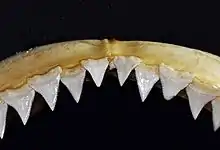
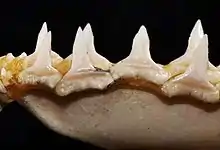
C. longimanus' most distinguishing characteristics are its long, wing-like pectoral and dorsal fins. The fins are significantly larger than most other shark species, and are conspicuously rounded. The shark's nose is rounded and its eyes are circular, with nictitating membranes.[7]
C. longimanus has a 'typical', although somewhat flattened requiem shark body, often with a mildly humpbacked aspect. It is grey-bronze dorsally and white ventrally, with some mottling on the fins.[8] The oceanic whitetip shark is a medium-sized requiem shark. The largest specimen ever caught measured 4 m (13 ft), an exceptionally large size considering few specimens are known to exceed a length of 3 m (9.8 ft). The maximum reported weight is 170 kg (370 lb). The female is typically larger than the male by 10 cm (3.9 in). Males attain sexual maturity at 1.7 to 1.9 m (5.6 to 6.2 ft) and females about 1.8 to 2.0 m (5.9 to 6.6 ft).[7][8] In the Gulf of Mexico in the 1950s, the mean weight of oceanic whitetip sharks was 86.4 kg (190 lb). In the 1990s, the sharks of the species from the same area averaged only 56.1 kg (124 lb).[12]
Most of its fins (dorsal, pectoral, pelvic and caudal) have white tips (juvenile specimens and some adults may lack these). Along with white tips, the fins may be mottled, and young specimens can have black marks. A saddle-like marking may be apparent between first and second dorsal fins.[7] The shark has several kinds of teeth. Those in the mandible (lower jaw) have a thin, serrated tip and are relatively small and triangular (somewhat fang-like). Between 13 and 15 teeth are on either side of the symphysis. The teeth in the upper jaw are triangular, but much larger and broader with entirely serrated edges—14 or 15 occur along each side of the symphysis.[7] The denticles lie flat and typically have between five and seven ridges.[7]
Diet
C. longimanus feeds mainly on pelagic cephalopods and bony fish.[3] However, its diet can be far more varied and less selective—it is known to eat threadfins, stingrays, sea turtles, birds, gastropods, crustaceans, and mammalian carrion. The bony fish it feeds on include lancetfish, oarfish, barracuda, jacks, mahi-mahi, marlin, tuna, and mackerel. Its feeding methods include biting into groups of fish and swimming through schools of tuna with an open mouth. When feeding with other species, it becomes aggressive.[8] Peter Benchley, author of Jaws, observed this shark swimming among pilot whales and eating their faeces.[13]
Behaviour
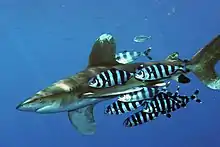
The oceanic whitetip is usually solitary and slow-moving, and tends to cruise near the top of the water column, covering vast stretches of empty water scanning for possible food sources.[7][14] Evidence in the form of sucker scars on the skin of an individual filmed off Hawaii indicate that the species may also dive deep enough to battle with giant squid.[15] Until the 16th century, sharks were known to mariners as "sea dogs"[16] and the oceanic whitetip, the most common ship-following shark,[8] exhibits dog-like behaviour when its interest is piqued: when attracted to something that appears to be food, its movements become more avid and it approaches cautiously but stubbornly, retreating and maintaining a safe distance if driven off, but ready to rush in if the opportunity presents itself. Oceanic whitetips are not fast swimmers, but they are capable of surprising bursts of speed. Whitetips commonly compete for food with silky sharks, making up for its comparatively leisurely swimming style with aggressive displays.[8]
Groups often form when individuals converge on a food source.[8] Segregation by sex and size does not seem to occur. Whitetips follow schools of tuna or squid, and trail groups of cetaceans such as dolphins and pilot whales, scavenging their prey. Their instinct is to follow baitfish migrations that accompany ocean-going ships. When whaling took place in warm waters, oceanic whitetips were often responsible for much of the damage to floating carcasses.[8]
Reproduction
Mating season is in early summer in the northwest Atlantic Ocean and southwest Indian Ocean, although females captured in the Pacific have been found with embryos year round, suggesting a longer mating season there.[8] The shark is viviparous—embryos develop in utero and are fed by a placental sac. Its gestation period is one year. Litter sizes vary from one to 15 with the young born at a length around 0.6 m (24 in).[1] Sexual maturity is reached around 1.75 m (69 in) for males and 2 m (80 in) for females.[1]
Relationship with humans
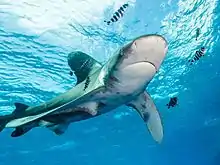
The oceanic whitetip is a commercially important species for its fins, meat, and oil. It is eaten fresh, smoked, dried, and salted and its hide is used for leather.[8] It is subject to fishing pressure throughout virtually its whole range,[1] although it is more often taken as bycatch than by design, since it is drawn to longline bait that is intended for other species.[8]
Oceanographic researcher Jacques Cousteau described the oceanic whitetip as "the most dangerous of all sharks".[17] Despite the greater notoriety of the great white shark and other sharks habitually found nearer the shore, the oceanic whitetip is suspected to be responsible for many fatal shark bites on humans, as a result of predation on survivors of shipwrecks or downed aircraft.[4][18] Such incidents are not included in common shark-bite indices for the 20th and 21st centuries, and as a result, the oceanic whitetip does not have the highest number of recorded incidents; only five bites had been recorded as of 2009.[19][20]
After the USS Indianapolis was torpedoed on 30 July 1945, most sailors who survived the sinking reportedly died from exposure to the elements rather than from shark bites.[21] However, according to survivor accounts published in several books about sharks and shark attacks, potentially hundreds of the Indianapolis crew were killed by sharks before a plane spotted them on the 5th day after the sinking. Oceanic whitetips are believed to have been responsible for most if not all of those attacks.[18][22] Also during World War II, the RMS Nova Scotia, a steamship carrying about 1,000 people near South Africa, was sunk by a German submarine. One hundred and ninety-two people survived; many deaths were attributed to the whitetip.[4]
In Egypt in 2010, one oceanic whitetip was implicated in several bites on tourists in the Red Sea near Sharm El Sheikh. The shark was recognised individually by the bite mark taken out of its upper tail lobe. Accumulating evidence revealed this shark to have been conditioned to being hand fed. Upon associating the divers with an easy supply of food, it bit the divers and snorkelers on the areas of the body where it had seen the fish being kept, namely, in the fanny packs the divers carried. This caused the shark to target the divers' buttock and thigh regions in the hope of obtaining a meal. The 2010 Sharm El Sheikh bites resulted in one death and four injuries to humans. The attacks might have been instigated by the overfishing in that area of the Red Sea, effectively forcing the shark closer to shore where the bites took place.[23][24]
Captivity
The oceanic whitetip has fared better in captivity than other large sharks of the open ocean, such as the mako and blue shark. Among five recorded captive oceanic whitetips, the three with time records all lived for more than a year in captivity. One of these, a female in Monterey Bay Aquarium's Outer-Bay exhibit, lived for more than three years before dying in 2003, during which it grew 0.3 m (1 ft).[25][26] The two remaining lack a time record, but grew about 0.5 m (1.6 ft) during their time in captivity.[25]
Conservation status
In 1969, Lineaweaver and Backus wrote of the oceanic whitetip: "[it is] extraordinarily abundant, perhaps the most abundant large animal, large being over 100 pounds [45 kg], on the face of the earth".[27] Little further population study occurred until 2003, when the numbers were estimated to have dropped by as much as 70% in the Northwest and Western Central Atlantic between 1992 and 2000.[1] Another study focusing on the Gulf of Mexico, using a mix of data from US pelagic longline surveys from the mid-1950s and observations from the late 1990s, estimated a decline in numbers in this location of 99.3% over this period.[5] However, changes in fishing practices and data collection methods complicate estimates.[28]
As a result of these findings, its status on the IUCN Red List was moved to "Critically Endangered" globally.
Under the 1995 UN Agreement on the Conservation and Management of Straddling Fish Stocks and Highly Migratory Fish Stocks, coastal and fishing states are specifically required to adopt measures to conserve listed species, but little progress is visible on the oceanic whitetip.[1]
From 3 January 2013, the shark was fully protected in New Zealand territorial waters under the Wildlife Act 1953.[29][30] The New Zealand Department of Conservation has classified the oceanic whitetip shark as "Migrant" with the qualifier "Secure Overseas" under the New Zealand Threat Classification System.[31]
In March 2013, the oceanic whitetip was added to Appendix II of CITES meaning the species (including parts and derivatives) require CITES permits for international trade.[32]
On 30 January 2018, NOAA Fisheries published a final rule to list the oceanic whitetip shark as a threatened species under the United States Endangered Species Act (ESA) (83 FR 4153).[33]
According to a January 2021 study in Nature which studied 31 species of sharks and rays, the number of these species found in open oceans had dropped by 71 per cent in around 50 years. The oceanic whitetip was included in the study.[34][35]
See also
- Blacktip reef shark
- List of sharks
- List of threatened sharks
- Outline of sharks
- Shark attack
References
- Rigby, C.L.; Barreto, R.; Carlson, J.; Fernando, D.; Fordham, S.; Francis, M.P.; Herman, K.; Jabado, R.W.; Liu, K.M.; Marshall, A.; Pacoureau, N.; Romanov, E.; Sherley, R.B.; Winker, H. (2019). "Carcharhinus longimanus". IUCN Red List of Threatened Species. 2019: e.T39374A2911619. doi:10.2305/IUCN.UK.2019-3.RLTS.T39374A2911619.en. Retrieved 19 November 2021.
- "Appendices | CITES". cites.org. Retrieved 2022-01-14.
- Froese, Rainer; Pauly, Daniel (eds.) (2013). "Carcharhinus longimanus" in FishBase. February 2013 version.
- Bass, A.J.; D'Aubrey, J.D.; Kistnasamy, N. (1973). Sharks of the east coast of southern Africa. 1. The genus Carcharhinus (Carcharhinidae) (PDF). Durban: Oceanographic Research Institute. pp. 49–55. ISBN 0869890085. Archived from the original (PDF) on 6 September 2013.
- Baum, J.K. & Myers, R.A. (2004). "Shifting baselines and the decline of pelagic sharks in the Gulf of Mexico" (PDF). Ecology Letters. 7 (3): 135–45. doi:10.1111/j.1461-0248.2003.00564.x. Archived from the original (PDF) on 2012-02-16.
- "Carcharhinus longimanus (Poey, 1861)". Integrated Taxonomic Information System. Retrieved 18 August 2008.
- Bester, Cathleen. "Oceanic Whitetip Shark". Florida Museum of Natural history. Archived from the original on 15 December 2012. Retrieved 22 July 2006.
- Compagno, Leonard J. V. (1984). Sharks of the World: An annotated and illustrated catalogue of shark species known to date. Vol. 4, Part 2. Carcharhiniformes. Food and Agriculture Organization of the United Nations. pp. 484–86, 555–61, 588. ISBN 978-92-5-101383-0. Archived from the original on 2013-08-22. Retrieved 2012-09-24.
- "Marine Life News". British Marine Life Study Society. Summer 2004. Archived from the original on 9 June 2017. Retrieved 3 September 2017.
- Eli. "Fishwatcher". Fishwatcher. Archived from the original on 8 December 2005. Retrieved 6 February 2006.
- Stafford-Deitsch, Jeremy (1988). Shark: A Photographer's Story. Sierra Club Books. ISBN 978-0871567338.
- "Consideration of Proposals for Amendment of Appendices I and II (CoP15 Prop. 16)" (PDF). Convention on International Trade in Endangered Species (CITES). March 2010. Archived from the original (PDF) on 2013-05-12.
- Benchley, Peter (2002). Shark Trouble. Random House. ISBN 978-0812966336.
- "Online Etymology Dictionary". Archived from the original on 2012-10-04. Retrieved 2006-08-08.
- "This shark fought off a deep-sea squid, first-ever picture reveals". Animals. June 5, 2020. Archived from the original on February 28, 2021. Retrieved October 19, 2021.
- Marx R.F. (1990). The History of Underwater Exploration. Courier Dover Publications. p. 3. ISBN 978-0-486-26487-5. Archived from the original on 2014-06-30. Retrieved 2016-07-15.
- Cousteau, Jacques-Yves & Cousteau, Philippe (1970). The Shark: Splendid Savage of the Sea. Doubleday & Company, Inc.
- Martin, R. Aidan. "Elasmo Research". ReefQuest. Archived from the original on 6 February 2006. Retrieved 6 February 2006.
- "ISAF Statistics on Attacking Species of Shark". Flmnh.ufl.edu. 2009-05-20. Archived from the original on 2012-08-31. Retrieved 2010-07-05.
- "Oceanic Whitetip". howstuffworks.com. 2008-06-05. Archived from the original on 2013-03-11. Retrieved 2010-01-03.
- Stanton, Doug (2003). In Harm's Way: The Sinking of the USS Indianapolis and the Extraordinary Story of Its Survivors (1st Owl Books ed.). New York: H. Holt. ISBN 978-0-8050-7366-9.
- Helm, Thomas (1969). Shark! Unpredictable Killer of the Sea (6 ed.). Collier Books.
- Egypt: German tourist killed in fourth Sharm el-Sheikh shark attack in a week Archived 2018-07-15 at the Wayback Machine. telegraph.co.uk (5 December 2010)
- US Experts Head to Egypt to Probe Shark Attacks Archived 2016-11-10 at the Wayback Machine. CBS News (7 December 2010)
- "Oceanic Whitetip Shark Carcharhinus longimanus (Poey, 1861) in Captivity". H. F. Mollet. Archived from the original on 15 May 2014. Retrieved 15 May 2014.
- "Monterey aquarium whitetip shark dies after three years". Napa Valley Register. Archived from the original on 2020-07-10. Retrieved 2020-07-10.
- Lineaweaver, Thomas H. III & Backus, Richard H. (1969). The Natural History of Sharks. Lippincott.
- Baum, J.K.; Kehler, D. & Myers, R.A. (2005). "Robust estimates of decline for pelagic shark populations in the northwest Atlantic and Gulf of Mexico". Fisheries. 30: 27–30. CiteSeerX 10.1.1.417.3687.
- "Endangered whitetip sharks to be protected". New Zealand Government. 27 September 2012. Archived from the original on 15 September 2016. Retrieved 27 September 2012.
- "Wildlife (Oceanic Whitetip Shark) Order 2012". New Zealand government gazette. 6 December 2012. Archived from the original on 5 February 2015. Retrieved 4 February 2015.
- Duffy, Clinton A. J.; Francis, Malcolm; Dunn, M. R.; Finucci, Brit; Ford, Richard; Hitchmough, Rod; Rolfe, Jeremy (2018). Conservation status of New Zealand chondrichthyans (chimaeras, sharks and rays), 2016 (PDF). Wellington, New Zealand: Department of Conservation. p. 9. ISBN 9781988514628. OCLC 1042901090. Archived (PDF) from the original on 2019-01-28. Retrieved 2019-01-17.
- MCGrath, Matt (11 March 2013). "'Historic' day for shark protection". BBC News. Archived from the original on 10 June 2013. Retrieved 27 July 2013.
- "Home page of NOAA Fisheries Service – Pacific Islands Regional Office". Archived from the original on 2018-06-22. Retrieved 2018-06-21.
- Briggs, Helen (28 January 2021). "Extinction: 'Time is running out' to save sharks and rays". BBC News. Archived from the original on 28 January 2021. Retrieved 29 January 2021.
- Richardson, Holly (27 January 2021). "Shark, ray populations have declined by 'alarming' 70 per cent since 1970s, study finds". ABC News. Australian Broadcasting Corporation. Archived from the original on 29 January 2021. Retrieved 29 January 2021.
Further reading
- Backus, Richard H.; Springer, Stewart; Arnold, Edgar L. (1956). "A contribution to the natural history of the white-tip shark, Pterolamiops longimanus (Poey)". Deep Sea Research. 3 (3): 178–188. Bibcode:1956DSR.....3..178B. doi:10.1016/0146-6313(56)90002-8.
- Compagno, Leonard J.V. (1984). "Sharks of the World". FAO Species Catalogue. Rome. 4, Parts 1 and 2.
- Compagno, Leonard J.V. (1988). Sharks of the Order Carcharhiniformes. Princeton University Press. ISBN 978-0-691-08453-4.
- Ellis, Richard (1976). The Book of Sharks. New York: Grosset & Dunlap.
- Eschmeyer, William N. (1998). Special Publication of the Center for Biodiversity Research and Information. Vol. 1–3. California Academy of Sciences. ISBN 978-0-940228-47-4.
- Froese, Rainer; Pauly, Daniel (eds.) (2005). "Carcharhinus longimanus" in FishBase. 09 2005 version.
- "Sharks: Silent Hunters of the Deep". Reader's Digest. Sydney. 1989.
External links
- "Introducing an ongoing study of the Oceanic Whitetip Shark in the Red Sea". longimanus.info.
- Oceanic Whitetip shark Carcharhinus longimanus at marinebio.org
- Photos of Oceanic whitetip shark on Sealife Collection
